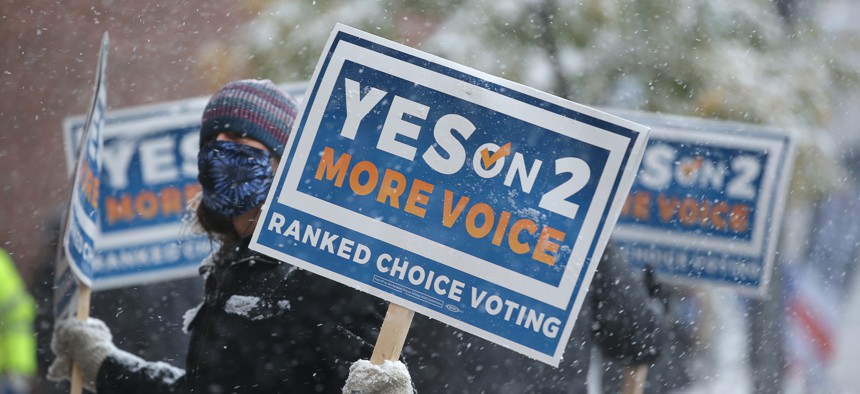Rank-choice Voting Advances as Election Deniers, Voting Right Limitations Gain Traction

Photo by Jonathan Wiggs/The Boston Globe via Getty Images
Two states and dozens of other jurisdictions have adopted ranked-choice voting for at least some elections.
While some 2020 presidential election deniers are winning Republican primaries and a number of state legislatures are passing laws to restrict voting rights, other states and jurisdictions have advanced measures that expand access to the ballot box and give voters more choice.
Represent Us, a nonpartisan group that opposes gerrymandering and advocates for measures such as ranked choice voting and more transparent campaign finance laws, issued a report Tuesday that chronicles prodemocracy wins across the U.S. over the past decade. They include legislation making it easier to obtain a mail-in ballot in Rhode Island, the passage of an anti-corruption resolution in Cook County, Illinois, the implementation of nonpartisan municipal elections in St. Louis and the passage of new campaign finance limits in Oregon.
One of the most significant developments in recent years is the spread of a ranked-choice system for elections, according to the nonpartisan group RepresentUs. Two states, one county and 52 cities--including San Francisco and New York--are expected to use ranked choice voting for at least some of their upcoming elections.
Voters in Maine cast ranked-choice ballots in the 2020 presidential election and similar systems are in place in several communities in Minnesota.
Alaska voters narrowly approved ranked-choice voting in 2020, but this month's primary for the state's open U.S. House of Representatives seat marked the first time it was used in a general election.
While the Alaska election is over, the results won’t be known a few weeks, according to the Anchorage Daily News, because the second ranking on voters’ ballots won’t be released until all ballots are counted on Aug. 31.
How It Works
Voters in rank-choice elections "rank" their choice of candidates. When the ballots are tallied, candidates with the lowest number of votes are eliminated. Then the votes are tallied again, but this time, second-choice votes count as well. The process continues until one candidate wins a majority.
Supporters say the system eliminates the "spoiler effect," which discourages voters from choosing the candidate that best reflects their views if that person has a slim chance of winning.
"The truth is that when ranked-choice voting is put into place ... the tenor of the political conversation becomes more civil and more moderated because people are fighting for second choice votes as well,'' said Josh Graham Lynn, CEO of RepresentUs, which is pressing for laws that strengthen democracy. "We see diversity of ideas and competition for the best ideas entering our politics which is something that's sorely missed right now."
The system has drawn criticism from former President Trump, who called it a "total rigged deal" at a rally in Anchorage, Alaska. In some states, the legislature has passed laws barring localities from instituting ranked-choice voting systems.
The opposition, Lynn said, is wary of ranked-choice voting because it opens up the political process. "You've got people who are in power who don't want to see anything change that would affect that power so they're passing laws ... to block these kind of reforms.''
Lynn predicts ranked-choice voting will continue to grow in popularity. Campaigns to bring the system to Nevada and Portland, Oregon, are gaining ground.
"The fact that there are new, viable campaigns happening and the fact we're seeing a reaction from the entrenched establishment tells me that there's actually is momentum here,'' he said. "It certainly won't happen overnight, but there's a long history in America of changes happening at the state level and becoming popularized because people see that they work ... and then it gets adopted more widely [at the] federal level and the same thing is possible here.''
Daniela Altimari is a reporter for Route Fifty.
NEXT STORY: $10B Redevelopment Slated for Downtown Miami





